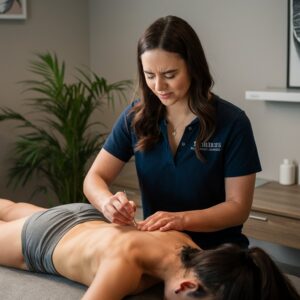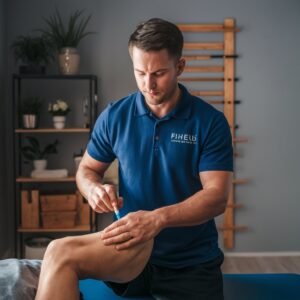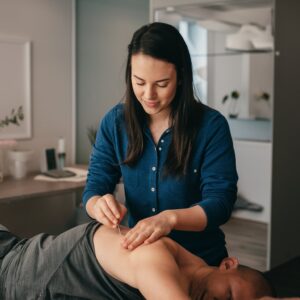Revolutionize Your Pain Management Strategy: Combine Dry Needling with Manual Therapy for Maximum Relief
In recent years, professionals in the fields of physical therapy, chiropractic, and various healthcare disciplines have increasingly recognized the efficacy of dry needling as a transformative therapeutic technique for managing **musculoskeletal pain** and tackling movement disorders. This cutting-edge method involves the careful insertion of ultra-fine needles into designated trigger points within the body, allowing practitioners to focus on specific areas of tension. By targeting these critical pressure points, healthcare providers can deliver targeted relief from stress and pain. Unlike acupuncture, which is grounded in the ancient traditions of Chinese medicine, dry needling is firmly rooted in **Western medical principles** and a solid understanding of neurophysiology. This distinction makes dry needling a scientifically validated approach to pain management, offering patients a modern solution to their discomfort.
The primary aim of dry needling is to locate and treat trigger points—hyperirritable areas within skeletal muscles that often present as palpable nodules or tight bands. The presence of these trigger points can lead to localized pain that may radiate to other areas, resulting in limited movement and muscle weakness. By effectively releasing these trigger points, dry needling not only provides remarkable pain relief but also enhances overall functional capacity. This allows individuals to return to their daily activities with a renewed sense of comfort and normalcy. The immediate and long-term benefits of this innovative technique can significantly enhance a patient's quality of life, making it a promising option for those grappling with chronic muscle tension and discomfort.
To achieve the best possible results, it is essential to incorporate dry needling into a holistic treatment plan. This plan may include physical therapy, targeted strengthening exercises, and additional therapeutic modalities. It is crucial that this safe and efficient procedure be performed by qualified healthcare professionals who have undergone extensive training and certification in dry needling techniques. Patients can take comfort in knowing that they will receive thorough information regarding the potential benefits and risks associated with dry needling before commencing treatment. This transparency allows patients to make informed decisions about their care, aligning their expectations with the realities of the therapy.
Furthermore, this therapeutic approach not only provides effective management of musculoskeletal pain but also has the potential to be synergistically combined with other manual therapy techniques, leading to improved outcomes and patient satisfaction.
Exploring the Key Advantages of Dry Needling: An In-Depth Analysis
- Dry needling serves as a highly effective technique for alleviating pain and improving functionality. By inserting thin needles into targeted muscle trigger points, practitioners can provide precise relief where it is needed most.
- The underlying science of dry needling focuses on stimulating the nervous system, which encourages the release of natural pain-relieving substances, effectively easing muscle tension and enhancing blood flow.
- By integrating dry needling with manual therapy, healthcare providers can significantly boost treatment results, effectively addressing the soft tissue pain associated with a range of musculoskeletal disorders.
- With the application of dry needling techniques, practitioners can accurately target muscle trigger points, alleviating pain while improving the range of motion. This makes dry needling an invaluable asset in managing muscle discomfort.
- Musculoskeletal pain can be effectively managed through the combination of dry needling and joint mobilization techniques, which directly target affected tissues and joints, offering a comprehensive solution to pain management.
 Delving into the Neurophysiology of Dry Needling: How It Relieves Pain Effectively
Delving into the Neurophysiology of Dry Needling: How It Relieves Pain Effectively
Triggering Local Twitch Responses: A Pathway to Muscle Relaxation
When a needle is inserted into a trigger point, it can elicit a local twitch response, causing the surrounding muscles to undergo a reflexive contraction. This involuntary twitch is thought to play a significant role in alleviating muscle tension and breaking the cycle of dysfunction and discomfort that many patients experience. By facilitating this reflexive reaction, dry needling effectively releases tight bands of muscle, promoting overall muscle relaxation and contributing to a notable decrease in pain levels. This mechanism is crucial for those seeking relief from persistent muscle tightness and discomfort.
Unlocking Pain Relief: The Body's Natural Neurophysiological Mechanisms
The insertion of a needle into a trigger point can stimulate the release of the body's inherent pain-relieving chemicals, known as endorphins. This natural process leads to immediate pain relief and a significant reduction in muscle soreness. Additionally, dry needling can influence the nervous system by modulating sensory nerve activity, effectively decreasing the transmission of pain signals to the brain. This desensitization of the nervous system not only provides immediate relief but also aids in preventing future episodes of discomfort, offering a dual approach to pain management that is both effective and sustainable.
Boosting Local Blood Flow: Enhancing Tissue Healing and Recovery
The introduction of microtrauma at the needle insertion site during dry needling promotes increased local blood flow, which accelerates the healing process of tissues. This enhanced circulation facilitates the delivery of essential oxygen and nutrients to the affected areas while also aiding in the removal of metabolic waste products. Ultimately, this process contributes to improved tissue health and function. Understanding the underlying science of dry needling equips both practitioners and patients with valuable insights into its physiological effects, such as pain reduction and improved functional mobility, which are critical for effective rehabilitation.
Maximizing Treatment Outcomes: The Synergy of Dry Needling and Manual Therapy
Integrating dry needling with various manual therapy techniques—such as joint mobilization, soft tissue mobilization, and stretching—can substantially enhance treatment effectiveness for those suffering from musculoskeletal pain and dysfunction. Manual therapy focuses on restoring natural movement patterns of joints and soft tissues, while dry needling specifically addresses trigger points and muscle tension. By merging these two approaches, healthcare practitioners can comprehensively address both the mechanical and neuromuscular aspects of pain and movement limitations.
For example, consider a patient experiencing shoulder pain and restricted mobility due to a rotator cuff injury. A skilled physical therapist might utilize manual techniques to improve joint mobility while concurrently employing dry needling to target trigger points in the surrounding musculature. This holistic strategy not only provides enhanced pain relief but also increases the range of motion and improves functional activities. Additionally, the combination of dry needling and manual therapy can extend the benefits of treatment by tackling the root causes of musculoskeletal dysfunction alongside the resulting pain.
Healthcare providers must possess a comprehensive understanding of both manual therapy and dry needling techniques to ensure their successful integration into individualized treatment plans. Equally crucial is the education of patients regarding these therapies, empowering them with knowledge about the purpose and expected outcomes of their treatments. By adopting this integrative approach, healthcare practitioners can deliver thorough and effective care to patients experiencing musculoskeletal discomfort.
Targeting Muscle Trigger Points: The Efficacy of Dry Needling Technique in Pain Management
The application of dry needling techniques enables healthcare providers to effectively identify and target muscle trigger points, thereby alleviating discomfort and dysfunction in patients. These hyperirritable areas within skeletal muscle often present as palpable nodules or taut bands, leading to localized pain, referred discomfort, restricted range of motion, and even muscle atrophy. By strategically inserting fine needles into these trigger points, practitioners can provoke a local twitch response that aids in releasing muscle tension and delivering substantial relief.
For instance, when a patient presents with low back pain exacerbated by prolonged sitting, a physical therapist may discover trigger points in the paraspinal muscles contributing to the discomfort. By applying dry needling techniques in these specific areas, the practitioner can effectively diminish pain and muscle tightness. Moreover, addressing trigger points through dry needling enhances muscle flexibility and function, allowing individuals to engage in daily activities with significantly reduced discomfort. A comprehensive assessment by qualified healthcare professionals is vital to identify trigger points accurately and determine if dry needling is an appropriate treatment option for each patient.
It is essential that patients receive clear and thorough communication regarding what to expect during their dry needling sessions, including any potential side effects or warnings. By focusing on trigger points and utilizing dry needling as a therapeutic method, healthcare providers can effectively manage muscular discomfort and dysfunction, offering patients a reliable strategy for pain relief.
 Enhancing Pain Relief: The Power of Combining Dry Needling with Joint Mobilization Techniques
Enhancing Pain Relief: The Power of Combining Dry Needling with Joint Mobilization Techniques
The integration of joint mobilization techniques with dry needling has proven to be an exceptionally effective strategy for addressing musculoskeletal pain and movement restrictions by targeting trigger points within the muscular system. Joint mobilization involves the application of specific pressures to a joint to restore its natural range of motion, while dry needling focuses on alleviating muscle tension in the surrounding tissues. By incorporating these two treatment modalities, healthcare professionals can effectively manage both the muscular and joint components of musculoskeletal disorders.
For example, in cases where a patient suffers from knee pain due to patellofemoral dysfunction, a physical therapist may implement joint mobilization techniques to enhance patella movement. Concurrently, they can apply dry needling to relieve trigger points in the quadriceps muscles. This comprehensive approach not only alleviates discomfort but also improves the patient's ability to perform functional activities such as walking, climbing stairs, and squatting. By addressing both the joint and muscular aspects of dysfunction, healthcare practitioners can optimize patient outcomes and provide a well-rounded treatment strategy.
To successfully integrate joint mobilization and dry needling into treatment plans, healthcare providers must possess an in-depth understanding of both procedures. Additionally, educating patients is crucial, as it empowers them to take an active role in their recovery and comprehend the rationale behind these interventions. By combining these methodologies, healthcare professionals can offer a more holistic approach to treating individuals with musculoskeletal discomfort, demonstrating their commitment to the long-term health and well-being of their patients.
Addressing Neuropathic Pain: The Impact of Dry Needling on Effective Pain Relief
Understanding the Intricacies of Neuropathic Pain
Neuropathic pain is a complex condition that arises when the nervous system is compromised or damaged, resulting in a variety of distressing symptoms. Patients may experience sharp, shooting sensations, burning pain, numbness, or tingling in different areas of the body. Trigger points associated with neuropathic pain can often be found along nerve pathways or within muscles that are innervated by the affected nerves, complicating the overall pain experience.
Utilizing Dry Needling as an Effective Remedy for Sciatica Pain
Individuals experiencing sciatica may suffer from neuropathic pain due to compression or irritation of the sciatic nerve. By skillfully identifying and treating specific trigger points along the sciatic nerve pathway, healthcare practitioners can significantly alleviate distressing symptoms such as leg pain and numbness. The targeted approach of dry needling allows for the reduction of neuropathic pain and enhances overall functionality by relieving tension in trigger points associated with nerve pathways.
Optimizing Dry Needling for Effective Nerve Pain Management
For healthcare providers to successfully employ dry needling as a therapeutic option for nerve pain, a comprehensive understanding of nerve anatomy and associated neuropathic pain syndromes is essential. Furthermore, it is vital to provide patients with detailed information regarding the dry needling process, including potential risks or precautions related to the treatment of nerve-related trigger points. By utilizing dry needling to address neuropathic pain, healthcare professionals can effectively target nerve-related symptoms, making a significant impact on improving patient quality of life and overall well-being.
 Empowering Patients Through Comprehensive Education: Understanding the Benefits and Risks of Dry Needling
Empowering Patients Through Comprehensive Education: Understanding the Benefits and Risks of Dry Needling
Patient education is crucial for the successful implementation of dry needling within manual therapy treatments. It is essential for patients undergoing this therapy to have a thorough understanding of the potential benefits, risks, and the overall procedural aspects of dry needling. Healthcare providers should dedicate time to explain the nuances of dry needling, outlining the treatment procedure while openly discussing any possible adverse effects, such as temporary discomfort or localized bruising at the needle insertion sites.
Moreover, educating patients about safety precautions regarding dry needling is vital. Patients should be advised to avoid strenuous physical activities immediately following the procedure and encouraged to communicate any unusual or prolonged symptoms to their healthcare provider. While dry needling can be an effective treatment for managing musculoskeletal discomfort, it may not be appropriate for every individual or condition. By enhancing patient education surrounding dry needling, healthcare providers can improve patient comfort during sessions and empower them to make informed decisions regarding their treatment options, ultimately reducing anxiety and enhancing the overall treatment experience.
Additionally, fostering open communication between patients and healthcare professionals is essential for addressing any questions or concerns related to dry needling. Patient education is fundamental for ensuring safety and achieving positive treatment outcomes when incorporating dry needling into various manual therapy approaches. By focusing on trigger points and integrating dry needling with other techniques, healthcare practitioners can effectively manage musculoskeletal pain and movement limitations.
A thorough understanding of the mechanics of dry needling, combined with a dedication to patient safety, is essential for effectively utilizing this technique in managing musculoskeletal pain.
What Is Dry Needling? A Comprehensive Overview of the Technique
Manual therapists, including physical therapists and chiropractors, utilize dry needling to effectively address **musculoskeletal pain** and movement limitations. This innovative procedure involves the insertion of fine needles into specific areas of muscle tension or trigger points, prompting the body to engage in its natural healing process. Grounded in modern medical principles, dry needling provides an effective means of pain management for a variety of conditions.
How Does Dry Needling Operate? Understanding the Mechanism Behind the Technique
At its core, dry needling focuses on trigger points—hyperirritable areas within skeletal muscles often accompanied by palpable nodules within taut bands of muscle fibers. By strategically inserting a needle into these precise trigger points, practitioners can effectively release muscle tension and promote improved blood circulation to the affected area. This process not only reduces pain but also enhances overall comfort, establishing dry needling as a valuable tool in the rehabilitation of musculoskeletal concerns.
Distinguishing Between Dry Needling and Acupuncture: Clarifying the Key Differences
While both dry needling and acupuncture utilize thin needles, they are distinct techniques founded on different principles. Acupuncture is rooted in ancient Chinese medicine, aiming to rebalance the body's energy flow, known as qi, by targeting specific meridians. In contrast, dry needling is based on Western medical principles and focuses on addressing specific musculoskeletal issues through the manipulation of trigger points, providing targeted pain relief.
Conditions That Can Benefit from Dry Needling: A Detailed List
Dry needling is an effective treatment option for a variety of musculoskeletal conditions. These may include neck pain, back pain, shoulder pain, hip pain, knee pain, and headaches, among others. Furthermore, it can effectively target issues such as muscle tightness, joint stiffness, and movement impairments, providing a well-rounded approach to pain management that addresses multiple facets of discomfort.
Is Dry Needling Safe? A Comprehensive Understanding of the Risks and Benefits
Dry needling is generally considered safe when performed by a skilled and licensed manual therapist. However, as with any medical procedure, there are potential risks and side effects to consider. These may include bruising, soreness, and, in rare cases, infection. It is essential to receive treatment from a qualified and experienced practitioner to minimize these risks and ensure a safe therapeutic experience.
How Many Dry Needling Sessions Are Typically Needed? Understanding Treatment Frequency
The number of dry needling sessions required can vary significantly based on individual needs and the specific condition being treated. While some patients may experience notable improvement after a single session, others might require multiple sessions to achieve the desired outcomes. A skilled therapist can collaborate with patients to develop a personalized treatment plan that aligns with their unique needs and therapeutic goals.
References for Further Learning and Exploration:
- Trigger Point Dry Needling. https://www.strattonspine.com/services/trigger-point-dry-needling/
- Health Benefits of Physiotherapy | How We Can Help You. https://www.corefitness.com.sg/benefits-of-physiotherapy-clinical-pilates/
Provided By:
The Article: Integration of Dry Needling in Manual Therapy appeared first on Dry Needling Clayton-le-Woods Preston
The Article Dry Needling and Manual Therapy: Effective Treatment Options appeared first on https://mcrtherapies.com
The Article Dry Needling and Manual Therapy: Effective Treatment Options for Pain Relief Was Found On https://limitsofstrategy.com




Comments are closed